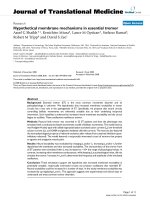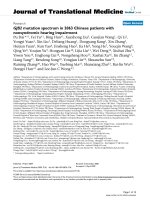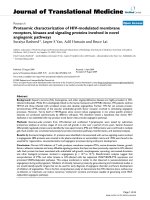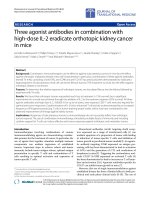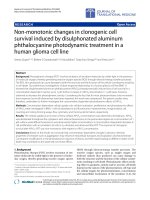Báo cáo hóa học: " Monitoring Charge Exchange in P3HT-Nanotube Composites Using Optical and Electrical Characterisation" docx
Bạn đang xem bản rút gọn của tài liệu. Xem và tải ngay bản đầy đủ của tài liệu tại đây (286.88 KB, 5 trang )
NANO EXPRESS
Monitoring Charge Exchange in P3HT-Nanotube Composites
Using Optical and Electrical Characterisation
Ioannis Alexandrou Æ Emmanouil Lioudakis Æ
Dimitrios Delaportas Æ C. Z. Zhao Æ Andreas Othonos
Received: 16 September 2008 / Accepted: 5 March 2009 / Published online: 19 March 2009
Ó to the authors
Abstract Charge exchange at the bulk heterojunctions of
composites made by mixing single wall nanotubes
(SWNTs) and polymers show potential for use in opto-
electronic devices such as solar cells and optical sensors.
The density/total area of these heterojunctions is expected
to increase with increasing SWNT concentration but the
efficiency of solar cell peaks at low SWNT concentrations.
Most researchers use current–voltage measurements to
determine the evolution of the SWNT percolation network
and optical absorption measurements to monitor the spec-
tral response of the composites. However, these methods
do not provide a detailed account of carrier transport at the
concentrations of interest; i.e., near or below the percola-
tion threshold. In this article, we show that capacitance–
voltage (C–V) response of (metal)-(oxide)-(semiconducting
composite) devices can be used to fill this gap in studying
bulk heterojunctions. In an approach where we combine
optical absorption methods with C–V measurements we
can acquire a unified optoelectronic response from P3HT-
SWNT composites. This methodology can become an
important tool for optoelectronic device optimization.
Introduction
Composites of polymers and nanotubes have attracted
much attention lately because they are lightweight, rela-
tively simple to fabricate, and are a low cost alternative
to current structural and electronic materials. In mecha-
nical applications nanotubes are used to increase the
stiffness and toughness of the host polymer [1] with
much research on dispersion methodologies [2, 3] and the
mechanical behavior of nanotubes and their arrays [4].
Polymer–nanotube electronic materials on the other hand
are set to explore the charge exchange at the polymer–
nanotube heterojunctions within the volume of the com-
posite. Optoelectronic characterization such as photolu-
minescence [5, 6] optoelectronic memory effect [7], and
photovoltaic response [8–16] suggest that nanotubes act
as electron donors to the polymer host. Even though the
mechanical properties of composites improve by
increasing the nanotube concentration, the electronic
response is usually optimum for low concentrations of
nanotubes [11, 14, 17]; usually close to the percolation
threshold.
In this article we use two different methodologies to
probe the interaction between poly (3-hexylthiophene),
(P3HT), and single wall nanotubes (SWNTs) and probe the
charge exchange at their heterojunctions. Optical linear
absorption and femtosecond transient absorption measure-
ments are then used to study P3HT–SWNT composites at
high SWNT concentrations. Electrical capacitance–voltage
measurements of metal-oxide-semiconductor (MOS) devi-
ces are then used to monitor charge exchange at SWNT
concentrations near or below the percolation limit. Our
results show that this combination of optical and electrical
methods provide a useful tool for studying charge
exchange in polymer–nanotube composites over a wide
I. Alexandrou (&) Á D. Delaportas Á C. Z. Zhao
Electrical Engineering and Electronics, University of Liverpool,
Liverpool L69 3GJ, UK
e-mail:
E. Lioudakis Á A. Othonos
Department of Physics, Research Center of Ultrafast Science,
University of Cyprus, P.O. Box 20537, Nicosia 1678, Cyprus
E. Lioudakis
Energy, Environment and Water Research Center, The Cyprus
Institute, P.O. Box 27456, Nicosia 1645, Cyprus
123
Nanoscale Res Lett (2009) 4:635–639
DOI 10.1007/s11671-009-9287-9
range of SWNT concentrations and therefore can help to
optimize their optoelectronic response.
Experimental
Composites of P3HT and SWNTs were prepared by mixing
appropriate amounts of the two materials dissolved in 1,2-
dichlorobenzene. SWNTs were obtained from CNI
(research grade purified Hipco SWNTs) and were used
without further functionalization. The composite solution
was then sonicated further until it was homogeneous.
Layers of the composite were drop cast on the substrate:
quartz discs for optical measurements; n
?
Si with 200 nm
thick thermally grown SiO
2
for capacitance–voltage (C–V)
measurements; glass for conductivity measurements. The
inset in Fig. 3 shows the geometry of the devices used for
C–V and I–V measurements. The heavily doped n
?
Si with
evaporated Al back contact serves as the gate during C–V
testing. All samples were dried in air overnight and then
were kept in vacuum for at least 12 h to ensure full drying
of the solvent. The Au top contacts for C–V and I–V
measurements were subsequently deposited by evapora-
tion. The Au contacts for C–V were 1 mm dots while for
I–V we used 200 9 200 lm square contacts at 50 l m
from each other. The C–V, I–V, and optical measurements
were performed in air. The ramp rate during C–V mea-
surements was 1 V/s and the peak-to-peak value of the
probing voltage was 50 mV.
For the time resolved measurements we have used a non
collinear super-continuum pump probe configuration in
conjunction with a regenerative Ti:Sapphire amplifier
system producing 100 fs pulses at 800 nm. The temporal
resolution of the system has been measured to be better
than 150 fs. In this work, optical pumping at a fluence of 2
mJ/cm
2
was used to excite the composites and determine
their temporal behaviour. Here, we should point out that
around this fluence non linear effects such as exciton–
exciton annihilation were not observed in our experimental
studies. More details on sample preparation and details of
our optical system can be found in a recent publication
[18].
Results and Discussion
Figure 1 shows the absorption spectra for the pure P3HT
polymer and three of its composites with SWNTs. As the
nanotube concentration increases, the composite solution
becomes thinner. Since our samples have been prepared by
drop casting similar amounts of the composite solution on
the substrate, films of composites with high SWNT
(\20 wt%) concentrations are visibly thinner. This affects
the absorption measured and we have therefore scaled all
curves in Fig. 1 so as all 2.1 eV peaks have the same
amplitude, similar to other reports in the literature [19]. As
a result we can safely compare the shape of the curves to
reveal structural characteristics but comparison of absolute
values requires careful attention. The main absorption in
the energy range studied here comes mainly from the
polymer but the fine structure in the absorption curves
between 2.1 and 2.4 eV disappears progressively as the
nanotube concentration increases. This change in absorp-
tion shows that the structure of the polymer is interrupted
by the incorporation of the nanotubes. According to recent
reports, the structure of the polymer can be strongly
modified at nanotube concentrations as low as 1 wt%
[20–22]. In these references, the composite preparation
involves particular steps to stimulate P3HT crystallization
on the nanotube walls. In our case the simple mixing of
P3HT and SWNTs reveal the same trend albeit at higher
SWNT concentrations. However, we do not expect to
affect the regioregularity and thus the basic properties of
P3HT.
In order to monitor the behavior of excited carriers in
these composites we have used the non collinear pump–
probe technique. In this method, the absorption change of
the material is continuously monitored at some pre-selected
wavelengths. An ultrashort laser pulse (pump) is used to
excite the carriers in the material and a second weak pulse
is used to follow the change in absorption immediately
afterwards with femtosecond resolution [23]. Figure 2
shows transient absorption measurements for the pure
P3HT polymer and P3HT/SWNT composites at a probing
wavelength of 600 nm (2 eV). According to the linear
absorption spectra of Fig. 1 using this wavelength we are
Fig. 1 Absorption spectra for P3HT–SWNT composites of various
concentrations. All spectra have been scaled to the 2. eV peak to
allow for decreasing film thickness with increasing SWNT concen-
tration. The vertical arrow indicates the energy of the pump beam
photons in pump–probe measurements shown in Fig. 2
636 Nanoscale Res Lett (2009) 4:635–639
123
probing absorption from the HOMO to states at the bottom
of the LUMO in P3HT. The initial excitation by the pump
pulse (3.1 eV) is immediately followed by a sharp decline
in absorption by the material. This is a direct consequence
of the monitored states being filled up by relaxing excitons
created by the pump pulse. Following this initial ‘state
filling’ the excitons relax further and the population of
empty states 2 eV above the HOMO increases with time.
This is translated into a fast increasing absorption by the
monitored states toward pre-pump levels. This latter
relaxation, apparent by the associated increase in absorp-
tion, is a measure of exciton life-time. Figure 2 shows that
in composites the lifetime of &2 eV excitons decreases
with SWNT concentration, evident by the fastest increase
in transient absorption. An estimation of exciton life-time
can be calculated by numerical fitting of the transient
absorption curves using an exponential decay (to model the
population of filled states in the LUMO). The inset in
Fig. 2 shows the variation in the time constant of the
exponential decay as function of nanotube concentration.
This data also shows that exciton dissociation in the
composite with 65 wt% SWNTs happens at almost double
the rate compared to pure P3HT. This data also shows that
in such composites exciton dissociation is indeed amplified
by the presence of nanotubes and supports the current
notion that the internal P3HT–SWNT junctions offer the
right condition for fast exciton dissociation. Our results
seem to agree well with the increase in short-circuit and
overall efficiency for polymer solar cell devices with the
addition of carbon nanotubes [8, 16].
However, useful optical measurements might be in
monitoring the optical response of polymer composites
and exciton dissociation in them, high efficiency of
electrophotonic devices such as solar cells and photo-
detectors require enhanced transport of separated carriers
and limited electron-hole recombination. Thus we need to a
methodology that monitors charge transport and carrier
exchange at the bulk heterojunctions. Here we have used
capacitance–voltage (C–V) measurements of the P3HT–
SWNT composites to address this issue. C–V character-
ization is very sensitive to even small changes in charge
concentration and can thus be used to detect charge capture
and release within a material. When characterizing poly-
mer–nanotube composites electronically, we need to keep
the SWNT concentration near or below the percolation
threshold. At higher SWNT concentrations the composite
behaves as a conductor and semiconducting characteriza-
tion will provide no useful data. Figure 3 shows the
conductance of P3HT–SWNT composites for SWNT
concentration up to 25 wt%. A mathematical fit of the form
of
y ¼ a Áðx Àx
c
Þ
t
provides the percolation threshold, x
c
, the dimensionality
of the SWNT network, t, and a is a proportionality con-
stant. As shown in Fig. 3 the fitting procedure proves x
c
=
0.75% wt and t = 1.61. The relatively low value of x
c
shows that SWNTs are well dispersed in our composites. In
three-dimensional networks percolation theory predicts an
exponent t = 2. Even though t values around 1.6 or less are
common in the literature [6, 21], in our case the lower
value of 1.61 is probably due to the horizontal arrangement
of the Au contacts used for I–V measurements (see inset of
Fig. 3; t = 1.5 for 2-D networks).
Fig. 2 Normalized transient absorption measurements for the P3HT
polymer and SWNT/P3HT composites at probing wavelength of
600 nm. The inset shows the time constant of the fast absorption
decay as a function of nanotube concentration
Fig. 3 Variation of electrical conductance as a function of SWNT
concentration. The mathematical fit indicates a percolation threshold
of 0.75. The inset show the device geometry used for C–V and I–V
measurements
Nanoscale Res Lett (2009) 4:635–639 637
123
Figure 4 shows the capacitance–frequency (C–F)
behaviour of P3HT–SWNT composites with SWNT
concentration ranging between 0.1 and 0.7 wt%. The
capacitance of the 200 nm SiO
2
layer (C
ox
) is noted on the
graph with a horizontal dashed line. In C–V measurements
the DC gate voltage (V
G
) is used to manipulate the con-
centration of carriers in the semiconductor (the composite
in our case) and a superimposed AC signal of very small
amplitude is used to measure the capacitance. The col-
lected data are processed to return an impedance that
consists of a capacitance in series with a resistor (series
configuration). The returned capacitance value is the dif-
ferential capacitance q Q/qV.C
ox
is in series with the
capacitance of the composite. In Fig. 4 the gate voltage is
high enough to keep the p-type composite in accumulation.
At frequencies where the majority carriers (holes) can
respond to the AC signal, the composite capacitance is
much larger than C
ox
and therefore the measured value
should be very close to C
ox
. At high frequencies
(f [ 30 kHz) there is limited response by the carriers to the
AC signal due to their limited mobility. As the frequency
increases the material behaves gradually as a dielectric and
the semiconductor capacitance becomes progressively
lower than expected at accumulation. The measured
capacitance, C, is given by
1
C
¼
1
C
ox
þ
1
C
comp
ð1Þ
where, C
comp
is the capacitance of the composite. C
comp
will decrease with increasing frequency and will eventually
become constant when the carriers in the composite almost
do not respond to the AC signal (f [ 300 kHz in Fig. 4).
Therefore, at high frequencies the measured capacitance is
expected to be lower than C
ox
, exactly as shown in Fig. 4.
In the frequency range between 7 and 30 kHz, the carriers
in our composites respond well to the AC signal and the
measured capacitance is close to C
ox
, again as expected
from Eq. 1. As the frequency of the AC signal decreases
below 3 kHz the measured capacitance starts increasing
and becomes many times larger than C
ox
. According to
Eq. 1 this is not possible. However, if charges injected into
the semiconductor do not appear across the capacitor, the
measured capacitance can be higher than C
ox
, an effect
often seen in leaky dielectrics [24– 26]. The photoelec-
tronic response of SWNT-polymer composites [5– 7, 14–
16, 21] has indicated that charge exchange can take place at
the bulk polymer–SWNT heterojunctions, with the SWNTs
acting as electron donors (or hole acceptors). The holes
trapped by the SWNTs in accumulation can be associated
with a current, a system response that is similar to the
existence of a leakage current. Charge exchange at the
SWNT–P3HT heterojunctions is a slow process that can
only be detected at low frequencies and therefore the
continuous increase in capacitance as the AC frequency
decreases.
Figure 4 shows that at a low frequency value, the
capacitance increases with increasing SWNT concentration
up to a value of SWNT concentration and then remains
almost unchanged. This trend is reproducible over several
sets of samples with the upper limit in SWNT concentra-
tion always being close to the percolation threshold (0.7–
1 wt%). As the nanotube concentration increases the total
area of P3HT–SWNT junctions should increase so the
saturation in the value of the low frequency capacitance is
not straightforward to explain. Firstly, as the nanotube
concentration increases in the composite solution, SWNTs
will tend to form bundles. The total area of the P3HT–
SWNT heterojunctions should still increase but at a lower
rate above a certain SWNT concentration. Our ultrafast
transient absorption measurements also showed a mono-
tonic decrease in exciton life-time with increasing SWNT
concentration, so the total area of bulk junctions does
increase. Secondly, the increased SWNT concentration
above the percolation threshold will make the composite
increasingly conductive and the semiconducting response
of the composite will diminish. The increased availability
of carriers at the interface means that albeit trapping at bulk
heterojunctions still taking place as shown by pump–probe
experiments, the device will behave as a single capacitor
with the n
?
S and the composite behaving as metals.
Therefore the low frequency capacitance will slowly tend
to become equal to C
ox
. These two competing factors will
tend to impose an upper limit to the value of accumulation
capacitance at low frequencies. The above explanation
needs to be verified with more experiments and this is the
immediate focus of our work. Our results agree well with
the work of Kymakis et al. [17] who have shown that
Fig. 4 Capacitance–frequency curves for P3HT–SWNT composites
with varying SWNT concentration at accumulation (V
G
=-40 V).
The Gate electrode is the n
?
Si (see inset of Fig. 3)
638 Nanoscale Res Lett (2009) 4:635–639
123
above a certain concentration of SWNTs, the semicon-
ducting response of the composite and the efficiency of
photovoltaic devices deteriorate. Our estimated limit in
SWNT concentration of 0.7 wt% is close to the concen-
tration at which these authors have measured their
maximum efficiency (1 wt%).
In summary, we have presented a combination of elec-
trical and optical methods for studying the charge exchange
at bulk P3HT–SWNT heterojunctions. The optical methods
show that at high SWNT concentrations the structure of the
polymer is altered as the polymer chains movement is
restricted. The change in structure is obvious from the
optical absorption spectra. Ultrafast transient absorption
measurements have been used here to monitor the popu-
lation of states at the bottom of P3HT’s LUMO with a
temporal resolution of 150 fs. The existence of SWNTs in
the composite accelerated exciton dissociation up to
SWNT concentrations of 65 wt%. However, the optical
methodologies explored could not provide detailed infor-
mation for very low SWNT loadings near the percolation
threshold (0.75 wt%). However, this is an extremely
interesting range of SWNT concentrations because, elec-
trically, the composites change from semiconducting to
almost metallic very rapidly for SWNTs concentrations
above the percolation threshold. Here we show that low
frequency C–V characterization is a methodology which
can be used to complement optical characterization and
detect charge exchange at P3HT–SWNT heterojunctions.
The signature of this interaction is the value of the accu-
mulation capacitance being higher than C
ox
at low
frequencies. In analogy to MOS devices with leaky
dielectrics, the higher than C
ox
value of accumulation
capacitance is a measure of the charges trapped by the
SWNTs at bulk junctions near the interface.
Acknowledgments The authors would like to thank Dr. S. Taylor in
the Department of Electrical Engineering and Electronics, University
of Liverpool for his critical help with C–V measurements. IA and EM
would also like to acknowledge partial funding of this work by the
University of Liverpool and grant ACCESS/0308/13 by the Research
Promotion Foundation in Cyprus.
References
1. R. Andrews, M.C. Weisenberger, Curr. Opin. Solid State Mater.
Sci. 8, 31 (2004)
2. M. Moniruzzaman, K.I. Winey, Macromolecules 39, 5194 (2006)
3. N. Hua, Z. Masuda, G. Yamamoto, H. Fukunaga, T. Hashida,
J. Qiu, Compos. Part A 39, 893 (2008)
4. R.B. Pipes, S.J.V. Frankland, P. Hubert, E. Saether, Compos. Sci.
Technol. 63, 1349 (2003)
5. J. Kumar, R.K. Singh, V. Kumar, R.C. Rastogi, R. Singh, Diam.
Relat. Mater. 16, 446 (2007)
6. I. Singh, P.K. Bhatnagar, P.C. Mathur, I. Kaur, L.M. Bharadwaj,
R. Pandey, Carbon 46, 1141 (2008)
7. A. Star, Y. Lu, K. Bradley, G. Gru
¨
ner, Nano Lett. 4, 1587 (2004)
8. E. Kymakis, G.A.J. Amaratunga, Appl. Phys. Lett. 80, 112 (2002)
9. E. Kymakis, E. Koudoumas, I. Franghiadakis, G.A. J. Amara-
tunga, J. Phys. D: Appl. Phys. 39, 1058 (2006)
10. E. Kymakis, I. Alexandrou, G.A.J. Amaratunga, J. Appl. Phys.
93, 1764 (2003)
11. B.J. Landi, R.P. Raffaelle, S.L. Castro, S.G. Bailey, Prog.
Photovolt.: Res. Appl. 13, 165 (2005)
12. S.P. Somani, P.R. Somani, M. Umeno, Diam. Relat. Mater. 17,
585 (2008)
13. J. Geng, T. Zeng, J. Am. Chem. Soc. 128, 16827 (2006)
14. S. B. Lee, T. Katayama, H. Kajii, H. Araki, K. Yoshino, Synth.
Met. 121, 1591 (2001)
15. C.D. Canestraro, M.C. Schnitzler, A.J.G. Zarbin, M.G.E. da Luz,
L.S. Roman, Appl. Surf. Sci. 252, 5575 (2006)
16. J. Arranz-Andres, W. Blau, Carbon 46, 2067 (2008)
17. E. Kymakis, P. Servati, P. Tzanetakis, E. Koudoumas, N. Kor-
nilios, I. Rompogiannakis, Y. Franghiadakis, G.A.J. Amaratunga,
Nanotechnology 18, 435702 (2007)
18 . E. Lioudakis, A. Othonos, I. Alexandrou, Nanoscale Res. Lett. 3,
278 (2008)
19. B. McCarthy, J.N. Coleman, R. Czerw, A.B. Dalton, M. in het
Panhuis, A. Maiti, A. Drury, P. Bernier, J.B. Nagy, B. Lahr, H.J.
Byrne, D.L. Carroll, W.J. Blau, J. Phys. Chem. B 106, 2210
(2002)
20. A.R. Adhikari, M. Huang, H. Bakhru, M. Chipara, C.Y. Ryu,
P.M. Ajayan, Nanotechnology 17, 5947 (2006)
21. A.W. Musumeci, G.G. Silva, J W. Liu, W.N. Martens, E.R.
Waclawik, Polymer 48, 1667 (2007)
22. H. Aarab, M. Baı
¨
toul, J. We
´
ry, R. Almairac, S. Lefrant, E.
Faulques, J.L. Duvail, M. Hamedoun, Synth. Met. 121, 1591
(2001)
23. E. Lioudakis, A. Othonos, I. Alexandrou, Y. Hayashi, Appl. Phys.
Lett. 91, 111117 (2007)
24. J. Schmitz, F.N. Cubaynes, R.J. Havens, R. de Kort, A.J.
Scholten, L.F. Tiemeijer, IEEE Electron Device Lett. 24,37
(2003)
25. K.J. Yang, C. Hu, IEEE Trans. Electron Devices
46, 1500 (1999)
26. Y. Lu, S. Hall, O. Buiu, J.F. Zhang, Microelectronics Eng. 4,
2390 (2007)
Nanoscale Res Lett (2009) 4:635–639 639
123

